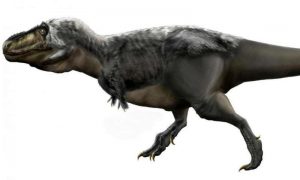
Restoration of a walking T. rex. Credit: Wikipedia/CC BY-SA 3.0
Some of the best dramatic moments in the movie Jurassic Park were seeing a Tyrannosaurus rex trying to chase down speeding vehicles. In reality, there have been great disagreements among paleontologists whether T. rex was really a fearsome hunter or more an opportunistic scavenger. A University of Manchester study headed by biomechanics expert William Sellers and paleontologist Phil Manning in 2007, used a powerful supercomputer to calculate the running speeds of five meat-eating dinosaurs that varied in size. The study believed to be the most accurate ever produced at the time involved feeding information about the skeletal and muscular structure of the dinosaurs directly into the supercomputer so it could extrapolate posture, gait, and biomechanics to determine how the animals were best able to move. The results published in the Proceedings of the Royal Society estimated the 6 ton T. rex moving at speeds of up to 18mph. Those finding made a powerful supporting argument for T. rex being a capable hunter.
Tyrannosaurus rex walking video via University of Manchester
But scientific research evolves with better technology and now scientists from the University of Manchester are saying we should slow down on running T. rex’s talk, literally. Using a new computer simulation to calculate the speed of the massive biped their findings indicate that if T. rex tried to go from a walk to running, the dinosaur’s legs would have collapsed and broken under the weight of its body. The study leader William Sellers (who published the earlier study above) summarized the calculation approach saying: “We present a new approach that combines two separate biomechanical techniques to demonstrate that true running gaits would probably lead to unacceptably high skeletal loads in T-Rex.” The study, published in the journal Peer J. found that was T. rex actually was quite slow and therefore not a pursuit predator.
Reference: PeerJ Journal “Investigating the running abilities of Tyrannosaurus rex using stress-constrained multibody dynamic analysis” William I. Sellers, Stuart B. Pond, Charlotte A. Brassey, Philip L. Manning, and Karl T. Bates










